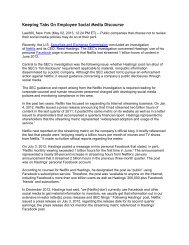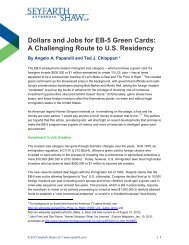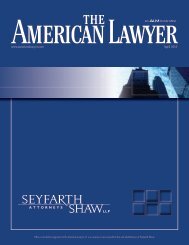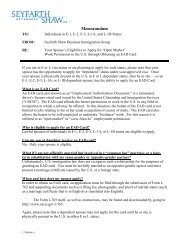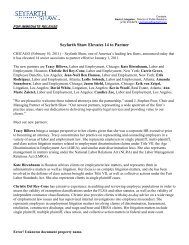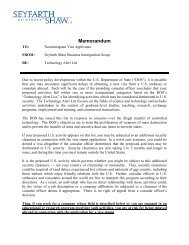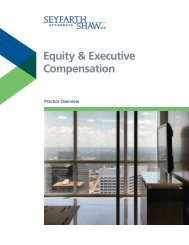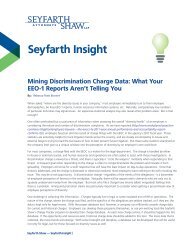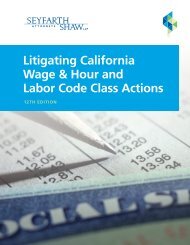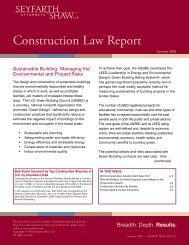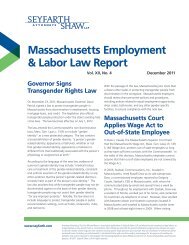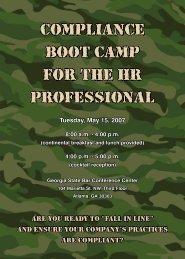Memorandum - Seyfarth Shaw LLP
Memorandum - Seyfarth Shaw LLP
Memorandum - Seyfarth Shaw LLP
You also want an ePaper? Increase the reach of your titles
YUMPU automatically turns print PDFs into web optimized ePapers that Google loves.
<strong>Memorandum</strong><br />
TO:<br />
FROM:<br />
Employees Seeking Nonimmigrant Visas<br />
<strong>Seyfarth</strong> <strong>Shaw</strong> Business Immigration Group<br />
DATE: January 6, 2010<br />
RE:<br />
General Information on Obtaining a Nonimmigrant Visa Stamp<br />
I. Purpose<br />
This <strong>Memorandum</strong> provides general information about obtaining a visa stamp at a United<br />
States consular post outside of the United States. This <strong>Memorandum</strong> also explains several<br />
processing alternatives which may be available to you. Please read this <strong>Memorandum</strong> carefully<br />
before directing any questions to <strong>Seyfarth</strong> <strong>Shaw</strong>. Note that the memorandum is not a legal<br />
opinion of <strong>Seyfarth</strong> <strong>Shaw</strong> or a guarantee or prediction of any future legal or factual outcome.<br />
II.<br />
General Need for Visa Stamp<br />
You may have received an original Notice of Approval (Form I-797), a copy of the<br />
nonimmigrant visa petition that was filed for you, and an e-mail from <strong>Seyfarth</strong> <strong>Shaw</strong> to your<br />
employer discussing the approval of your nonimmigrant visa petition. Please note, however,<br />
that if you plan to travel internationally to any country other than Canada or Mexico – or<br />
if you plan to travel to Canada or Mexico for more than 30 days - you must have a valid<br />
visa stamp in your passport in order to return to the U.S. For example, if you are a citizen of<br />
India who has just changed status from F-1 student status to H-1B employee status, you may go<br />
to Mexico or Canada for 30 or fewer days and return with your old F-1 visa stamp and your new<br />
approval notice. However, if you plan to visit any other country, you cannot return to the United<br />
States until you first obtain an H-1B nonimmigrant visa stamp.<br />
Note that Canadian nationals generally do not need a visa stamp in order to return to the<br />
United States after international travel.<br />
III.<br />
Traveling on an Existing Valid Nonimmigrant Visa<br />
Applying for a visa through the U.S. embassies and consulates abroad has become more<br />
complicated and time-consuming as a direct result of the government’s increased security<br />
AT1 32610559.3
Page 2<br />
measures. These new procedures can lead to extended delays that could prevent you from reentering<br />
the United States for weeks or months at a time. For this reason, we encourage you to<br />
consider traveling on an existing valid nonimmigrant visa stamp.<br />
If you already have an unexpired employment-based nonimmigrant visa stamp in your<br />
passport (such as an H-1B, L-1, or O-1), and if it matches your current immigration status, it may<br />
not be necessary for you to obtain a visa stamp in order to return to the United States For<br />
example, if you are in H-1B status, and already have an H-1B visa stamp in your passport that<br />
will remain unexpired on the day of your proposed return to the United States, then you do not<br />
require a new visa stamp. Instead, you may re-enter the United States with the existing visa<br />
stamp (even if it reflects the name of your former employer) and your original approval notice<br />
indicating your current employer.<br />
IV.<br />
Applying for the Nonimmigrant Visa at a U.S. Consular Post<br />
If the above alternative is not available to you and if you are required to travel<br />
internationally, then you will need to apply for the nonimmigrant visa stamp at a U.S. consular<br />
post while you are outside the United States.<br />
A. General Information About Timing<br />
With limited exceptions, getting a visa stamp now requires a personal interview, and<br />
many consular posts have significant (weeks or months) interview appointment lead times. It is<br />
usually difficult or impossible to accelerate the scheduling of an appointment. At many consular<br />
posts there may be an additional period of up to several weeks between the interview<br />
appointment date and the date the consular post returns the passport containing the new visa.<br />
To minimize potential delay and disruption of travel, if you are or will be required to<br />
obtain a visa stamp in order to enter the United States, you need to contact the U.S. Embassy or<br />
Consulate where you intend to process in order to book an interview appointment and to<br />
determine approximately how long it will take the consular post to issue the visa stamp and<br />
return your passport to you. Go to http://travel.state.gov/visa/temp/wait/tempvisitors_wait.php to<br />
access the web site for the U.S. consular post where you will process.<br />
Further, if you are a citizen of one of the countries affected by post-9/11 legislation -- or<br />
if your occupational field involves an area which could be considered by the government as a<br />
potential threat to U.S. security -- then you may encounter additional delays in visa processing.<br />
Please be aware that even if your country of citizenship is not included in the post-9/11<br />
legislation or if your line of work is in no way detrimental to U.S. security, a consular officer<br />
may, at his or her discretion, require you to undergo additional security screening. You can read<br />
more about the post-9/11 legislation (including the “NSEERS” or National Security Entry Exit<br />
Registration System) by visiting www.immstar.com and clicking on NIV Memoranda to access<br />
the document entitled “Nationalities Affected by Post 9/11 Legislation.” You can obtain more<br />
information about occupations that may be considered to involve risks to U.S. security by<br />
visiting www.immstar.com and clicking on NIV Memoranda to access the document entitled<br />
“Technology Alert List.”<br />
AT1 32610559.3
Page 3<br />
You should be aware that in November 2007, the Department of State implemented a<br />
Petition Information Management System (“PIMS”) that requires that all U.S. consular posts<br />
obtain electronic verification from the Kentucky Consular Center of all H, L, O, P and Q visa<br />
petition approvals before issuing visa stamps. Under normal circumstances, it should take the<br />
consular post no more than two days to obtain this electronic verification, so you should be<br />
prepared for visa processing to take an additional two days. If your visa issuance is delayed for<br />
more than 48 hours after your visa interview due to PIMS verification, please contact <strong>Seyfarth</strong><br />
<strong>Shaw</strong>.<br />
Note that you should notify <strong>Seyfarth</strong> <strong>Shaw</strong> as soon as possible if you have ever been<br />
arrested, convicted of a crime, pled guilty to a criminal charge, or have any other criminal<br />
history, including severe traffic violations (such as driving under the influence/drunk<br />
driving), as such incidents may significantly impact your visa processing procedure.<br />
B. Where Should You Apply for the Visa?<br />
The absolute best place for you to apply for a nonimmigrant visa is at a U.S. consular<br />
post in your home country or the post closest to your foreign residence. Applying in your home<br />
country or in your country of foreign residence generally results in a quicker application process<br />
and eliminates some possible obstacles to visa issuance.<br />
C. Are You Required to Process in Your Home Country?<br />
There is no better place for you to apply for a visa than in your home country. This<br />
is because: (1) as a citizen or resident of that country, you have the greatest right to present<br />
yourself at a consular post located there; and (2) the consular staff in your home country will be<br />
the most familiar with the evidence you will provide, including educational background,<br />
financial support, and any other important political, social, or cultural factors that are relevant to<br />
your case.<br />
D. What About Applying for the Visa in Canada or Mexico?<br />
If you apply for a visa stamp in a country other than your home country, you are<br />
considered by the U.S. authorities to be a “TCN.” A TCN is a “Third Country National.” It<br />
means that you are neither a national of the U.S. nor of the country in which you are now trying<br />
to obtain a visa. For example, a Greek citizen who applies to the U.S. consulate in Toronto,<br />
Canada is a “TCN” because he or she is neither a U.S. citizen nor a Canadian citizen.<br />
You might wish to consider the possibility of TCN processing in Canada or Mexico, but<br />
note that there is no guarantee that a TCN applicant will receive a visa. The consular officer may<br />
deny your case and ask you to apply instead in your home country. In such a case, it is likely to<br />
be noted in your passport as a “Denial Without Prejudice,” i.e. there was nothing wrong with the<br />
merits of your case but the location of the application was unsuitable. Note further that if you<br />
have been denied a visa in Canada or Mexico, you are not allowed to re-enter the U.S. until<br />
you return to your home country and get a new visa stamp.<br />
AT1 32610559.3
Page 4<br />
You can obtain more detailed information about the TCN visa application process by<br />
visiting www.immstar.com and clicking on NIV Memoranda to access the document entitled<br />
“TCN Processing.”<br />
V. What Documents Do You Need to Present to Get the Visa?<br />
A. Documents Needed for Your Application<br />
You will need to present the following documents:<br />
1. A passport valid for at least six (6) months into the future.<br />
Each applicant will receive an individual visa, and each Machine Readable Visa<br />
(“MRV”) covers a full page. Therefore, passports must contain at least one blank,<br />
unmarked visa page to accommodate a U.S. visa.<br />
2. The original Form I-797 (Notice of Approval) issued by the USCIS.<br />
The form will indicate your current employer and the approval period for the<br />
work assignment.<br />
3. A copy of the entire visa petition.<br />
We sent you a complete copy of the visa petition at the time of filing. It contains<br />
all the forms and exhibits that we submitted to the USCIS. Please bring this entire<br />
petition - do not separate the pages.<br />
4. A copy of a company brochure or a recent Annual Report.<br />
You can obtain this from your Human Resources office.<br />
5. Form DS-156 or Form DS-160<br />
You must complete a Form DS-156 (Non-Immigrant Visa Application Form) or<br />
Form DS-160, depending on at which consular post you will apply. Both forms<br />
must be completed on-line and then printed. Thus, you should access<br />
http://travel.state.gov/visa/frvi/forms/forms_1342.html to complete and submit the<br />
Form DS-156 or DS-160, which will print with a barcode on the last page.<br />
6. Form DS-157.<br />
There are two categories of people who must complete the DS-157. They are:<br />
(i) All male visa applicants, regardless of nationality, between the ages of 16<br />
and 45; and,<br />
AT1 32610559.3
Page 5<br />
(ii)<br />
All male and female applicants, regardless of age, with passports or travel<br />
documents from China (PRC), Cuba, Iran, Iraq, Libya, Russia, Somalia,<br />
Sudan or Vietnam<br />
Further, the DS-157 may be required for all visa applicants, depending on the<br />
consular post where you are processing. The new DS-157 is a challenge to<br />
complete. For this reason, you should allow extra time to make sure that you are<br />
completing it thoroughly and correctly. In addition to asking you to state your<br />
official nationality, the form asks you to list any affiliations to ethnic or cultural<br />
groups, all the names and name spellings you ever used, all the countries you have<br />
visited in the last 10 years, your history of military service, and all postelementary<br />
schools you have attended. You can download this form from the<br />
State Department website, or you can ask our office to send you a copy. For<br />
further information on completing the Forms DS-156/157, please visit<br />
www.immstar.com and click on NIV Memoranda to access the document entitled<br />
“Completing Forms DS-156/157.”<br />
Please note: the DS-157 is NOT required for applicants who complete Form DS-<br />
160 in lieu of the DS-156.<br />
7. Photograph<br />
One passport-size photograph for each applicant, with the applicant facing the<br />
camera. The background must be white or light, and the photograph dimensions<br />
should be 50mm by 50mm.<br />
8. Machine Readable Visa Fee<br />
There is a mandatory $131.00 non-refundable fee for each Machine Readable<br />
Visa. In some cases, you may have the option of paying with local currency.<br />
Please check with your specific consular post for further information.<br />
9. “Reciprocity Fee.”<br />
In addition, citizens of certain countries must also pay a “Reciprocity Fee.”<br />
Reciprocity fees vary from country to country. To find out if you must pay a<br />
reciprocity fee and to determine the exact amount, go to the reciprocity tables<br />
located at the Department of State web site at<br />
http://travel.state.gov/visa/frvi/reciprocity/reciprocity_3272.html.<br />
10. Employment letter.<br />
This letter should identify your name, job title, and annual salary. It should<br />
confirm that you continue to work with your present employer. This letter must<br />
be on company letterhead and signed by a Manager or Human Resources<br />
professional.<br />
AT1 32610559.3
Page 6<br />
B. Documents Needed for the Visa Application of a Family Member<br />
If you are recently married and wish to obtain a dependent visa for your spouse, or for<br />
any unmarried children under the age of 21, please make sure that you read carefully the section<br />
on where to apply. In addition, please note that first-time applications by spouses of newlywed<br />
H-1Bs or L-1s should only be made at a consular post in the home country.<br />
The documents listed above in items 1-10 must be presented for family members as<br />
well as for the principal applicant. In addition to the documents listed above, you must<br />
provide the following:<br />
1. Birth Certificate.<br />
For each child, you must provide an original birth certificate confirming that you<br />
are the child’s parent.<br />
2. Marriage Certificate.<br />
An original marriage certificate that lists the full names of each spouse along with<br />
the place and date of the marriage. If it is not in English, it must be translated into<br />
English.<br />
3. Wedding Photograph<br />
To guard against fraud, many consular officers will wish to see a photograph of<br />
the wedding. Please be prepared to present one if necessary.<br />
4. Bank Statement<br />
Dependents of H-1B visa holders are not permitted to work. Thus, the H-4 spouse<br />
should also be prepared to present evidence of savings. It is advisable to have<br />
prepared a bank statement or bank letter (either from the home country or the<br />
U.S.) noting amounts that the couple has in a checking or savings account. This<br />
may be a joint or individual account.<br />
5. I-797 Approval Notice<br />
If your spouse or child has resided in the U.S. and filed for a change or extension<br />
of status using Form I-539, they may wish to carry with them their original Form<br />
I-797 Notice of Approval and present it for the U.S. consular officer’s inspection<br />
if requested.<br />
AT1 32610559.3



